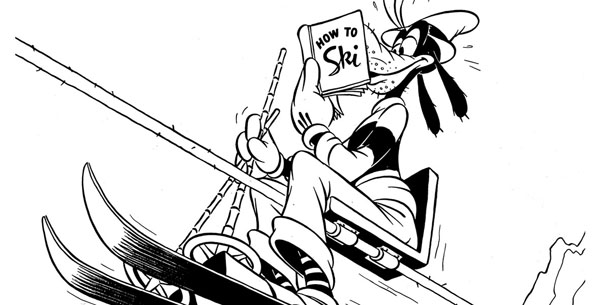
Cataloging sports cartoons can generally be a little daunting – as there were soooooo many of them produced. However, at least one sport actually doesn’t seem to have been as overdone as the rest, fitting for the setting in of the winter season – skiing. So put on your goggles, earmuffs, and bundle up warm for a bumpy ride over the snow capped mountains, dreamed up by the movie moguls of Hollywood’s golden era of animation.
Surprisingly, little or nothing has surfaced from the silent animation days to reflect any treatment of the sport. It appears early animators were more fixated upon the activities of skating and sledding than with getting anyone standing up on skis. Only title hints of any possibilities of skiing appearances are found in existing internet records, from the presumably winter-themed titles of Mutt and Jeff, On Ice (1918), Mutt and Jeff in Switzerland (1919), The Frozen North (1919), The Far North (1922), and Any Ice Today (1922), and from the Terry Aesop’s Fables On the Ice (1924), An Alpine Flapper (1926), and Cracked Ice (1927). Also an unknown is the early Terrytoons “talkie”, Swiss Cheese (5/6/30). Anyone with information on any of these titles, or on any other likely silents, is of course encouraged to add their contributions below.
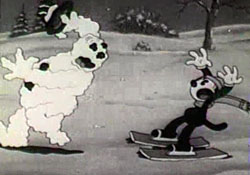 So far, the earliest use of skiing in a cartoon I have located is Krazy Kat’s Snow Time (Charles Mintz/Columbia, 11/30/32 – Ben Harrison/Manny Gould, dir.). A typical Mickey Mouse/Bosko style outing at the skating pond with Kitty develops an unexpected complication when Krazy tries to jump in his skates over a row of barrels. Misjudging the distance, Krazy crashes into the last barrel of the column – braking it into slats, two of which stick to his feet as skis. He slides uncontrollably down the pond, jumping over small snow mounds. Some kids ahead are building a snowman. They not only run at the approach of Krazy – but the snowman does, too. To gain speed, the snowman unzips his “snow” suit, revealing a skeleton inside, and tosses the snow back at Krazy, who grows into a giant snowball. The snowball gains size by plowing over two snow-covered trees, absorbing their white covering. The ball “bowls” down a triangle of trees in its path. It hits a log cabin, sending all the logs flying skyward and leaving only the cabin’s occupant sound asleep in a bed – then all the logs fall from the sky to rebuild the cabin intact around him. The snowball enters a barn, absorbing all the farm animals – then rolls over a clothesline, also sucking in all of the farmer’s wash. Finally, the snowball hits a wall. Krazy is ejected, and the snowball disintegrates – revealing all the farm animals now attired in the Farmer’s Sunday-best outfits.
So far, the earliest use of skiing in a cartoon I have located is Krazy Kat’s Snow Time (Charles Mintz/Columbia, 11/30/32 – Ben Harrison/Manny Gould, dir.). A typical Mickey Mouse/Bosko style outing at the skating pond with Kitty develops an unexpected complication when Krazy tries to jump in his skates over a row of barrels. Misjudging the distance, Krazy crashes into the last barrel of the column – braking it into slats, two of which stick to his feet as skis. He slides uncontrollably down the pond, jumping over small snow mounds. Some kids ahead are building a snowman. They not only run at the approach of Krazy – but the snowman does, too. To gain speed, the snowman unzips his “snow” suit, revealing a skeleton inside, and tosses the snow back at Krazy, who grows into a giant snowball. The snowball gains size by plowing over two snow-covered trees, absorbing their white covering. The ball “bowls” down a triangle of trees in its path. It hits a log cabin, sending all the logs flying skyward and leaving only the cabin’s occupant sound asleep in a bed – then all the logs fall from the sky to rebuild the cabin intact around him. The snowball enters a barn, absorbing all the farm animals – then rolls over a clothesline, also sucking in all of the farmer’s wash. Finally, the snowball hits a wall. Krazy is ejected, and the snowball disintegrates – revealing all the farm animals now attired in the Farmer’s Sunday-best outfits.
Alpine Antics (Warner, Looney Tunes, 5/9/36, Jack King, dir.). Surprisingly, this film was included as a newcomer title to Warner Brothers’ package of computer-colorized Looney Tunes for Cartoon Network, although it was not one of the titles chosen for the older “hand traced” color travesties of the 1970’s. It’s odd that anyone remembered it, as it only includes a three shot cameo for Porky Pig, and is nearly entirely a feature for Beans the Cat (whose other notable episodes, like “Hollywood Capers”, “The Phantom Ship”, and “A Cartoonist’s Nightmare”, never got the color treatment). Not to say that everything with Porky was eligible for colorizing – nobody thought to colorize “Westward Whoa”, in which his part is substantially more sizeable.
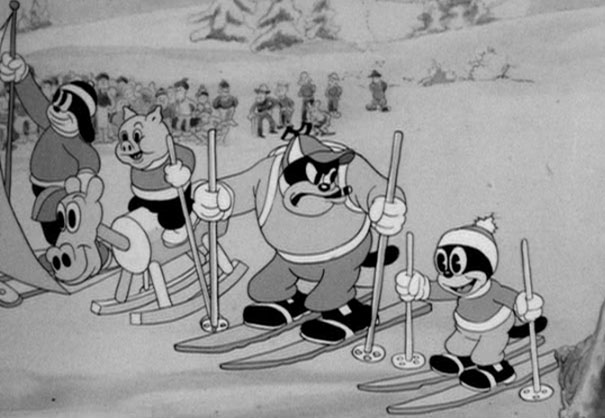
While opening segments of this film center on ice-skating, the primary action begins when Beans spots a poster advertising a big ski race (seemingly, the first such event in animated cartoons). “$100,000,000 in prizes or a cool $2.00 cash to the winner.” But boastful Beans has a rival – a “Black Pete” look-alike (also voiced by Billy Bletcher, too), who busts up his skis. No worry – Beans borrows another pair off a makeshift snowmobile. At the stating line, several other entrants try to have their own “edge” – a dog has a bicycle-pedaled contraption that looks like a land equivalent of a riverboat stern paddlewheel. Porky attempts to ride to victory upon the wooden runners of a rocking horse. Another contestant uses a sail and fireplace bellows for wind. And a dachshund is too long for a single pair of skis – so rides aboard four of them. Beans arrives to the consternation of the bully – who pulls Beans’ hat over his eyes, then ties to one of his skis a skyrocket facing in the wrong direction. He lights the rocket’s fuse, and Beans jets backwards into a cabin, perforating its roof with a zig-zag trail of holes. The starter’s gun goes off, and Beans has to catch up from a late takeoff. The villain performs a ski jump in a pair of nicely-animated perspective shots – then cheats on his landing with a built-in parachute. He stops at a pair of closely-placed tree trunks and strings a rope across to trip the contestants up. Almost everyone gets upset into a snowbank except Beans, who snaps the rope, causing it to loop around the villain and temporarily tie him to one tree.
Beans tries to jump a ravine, but just misses the other ledge, his skis lodging in the side of the cliff face. The villain gets free and jumps right over him. Fortunately, the dachshund is lagging behind, and instead of jumping the chasms dips down into it and back up again, colliding with Beans on the uphill slope and freeing him. Beans and the villain do some fancy slolums between trees, then take some unusual loops from obstacles in their path, causing the villain to ride Beans piggyback. But the villain gets tied up in a springy tree limb, which unwinds back to shape and catapults the villain over Beans’ head. The finosh line is near, and it looks as if the villain will win. But his lands on thin ice, which breaks open with an ice floe that flips over, dunking the villain in the water and leaving a clear surface for Beans to reach the finish line. The villain still spoils Beans’ thunder in the winner’s circle, by coming up under him through the ice, toppling Beans through a second hole into the chilly water, where they shiver for the iris out.
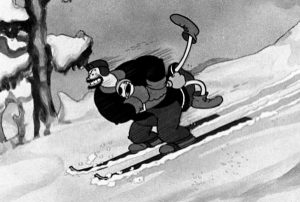 I-Ski Love-Ski You-Ski (Fleischer/Paramount, 4/3/36, Dave Fleischer, dir., Willard Bowsky/George Germanetti, anim.), marks Popeye’s first encounter of many with the sport – although in this one, it actually takes a back-seat to mountain climbing. Popeye and Bluto as usual play rivals for the company of Olive on a mountain jaunt, with the memorable original song, “Won’t You Come and Climb the Mountain With Me?” A game of “Eeeny Meeny Miney Mo” gets Popeye chosen, and Bluto vengeful. After rigging several mishaps for the couple during their ascent, Bluto finally meets them at the summit wearing skis, and kicks Popeye over the edge. Popeye eats his spinach in mid-fall, and miraculously reverses course to shoot upwards like a bullet. Bluto takes off with Olive, and Popeye gives chase by socking a tree, which disintegrates into a pair of skis and poles. Olive misses out on most of the action by snagging her feet on an overhanging tree limb and “hanging around” there for nearly the remainder of the episode. Popeye catches up to Bluto in mid-jump over a ravine. The two take paths on opposite sides of a trail which periodically opens in the middle to wide and dangerous chasms. Each takes turns socking the other at each narrowing of the path, and dodges the canyons at each widening of the gap. Bluto zooms around a curving ledge, causing a strip of rock to fall away from the outside arc. Popeye only succeeds in making the turn by balancing on one ski, which is the width of what’s left of the ledge. Both leap off a ski jump – but Popeye hits a higher elevation and bops Bluto in the head with his skis. “I’ll be skiing ya”, says Popeye, and winds up for his finishing blow – smacking Bluto through three snowdrifts and onto a floe of ice in the river. Meanwhile, Olive finally lets go of the tree, starts slipping, and careens down the hill, her legs spreading apart across two opposite ledges and her screaming face almost flying into the camera lens. Popeye of course performs a nick-of-time catch, and delivers his “toot toot” half buried in snow under her.
I-Ski Love-Ski You-Ski (Fleischer/Paramount, 4/3/36, Dave Fleischer, dir., Willard Bowsky/George Germanetti, anim.), marks Popeye’s first encounter of many with the sport – although in this one, it actually takes a back-seat to mountain climbing. Popeye and Bluto as usual play rivals for the company of Olive on a mountain jaunt, with the memorable original song, “Won’t You Come and Climb the Mountain With Me?” A game of “Eeeny Meeny Miney Mo” gets Popeye chosen, and Bluto vengeful. After rigging several mishaps for the couple during their ascent, Bluto finally meets them at the summit wearing skis, and kicks Popeye over the edge. Popeye eats his spinach in mid-fall, and miraculously reverses course to shoot upwards like a bullet. Bluto takes off with Olive, and Popeye gives chase by socking a tree, which disintegrates into a pair of skis and poles. Olive misses out on most of the action by snagging her feet on an overhanging tree limb and “hanging around” there for nearly the remainder of the episode. Popeye catches up to Bluto in mid-jump over a ravine. The two take paths on opposite sides of a trail which periodically opens in the middle to wide and dangerous chasms. Each takes turns socking the other at each narrowing of the path, and dodges the canyons at each widening of the gap. Bluto zooms around a curving ledge, causing a strip of rock to fall away from the outside arc. Popeye only succeeds in making the turn by balancing on one ski, which is the width of what’s left of the ledge. Both leap off a ski jump – but Popeye hits a higher elevation and bops Bluto in the head with his skis. “I’ll be skiing ya”, says Popeye, and winds up for his finishing blow – smacking Bluto through three snowdrifts and onto a floe of ice in the river. Meanwhile, Olive finally lets go of the tree, starts slipping, and careens down the hill, her legs spreading apart across two opposite ledges and her screaming face almost flying into the camera lens. Popeye of course performs a nick-of-time catch, and delivers his “toot toot” half buried in snow under her.
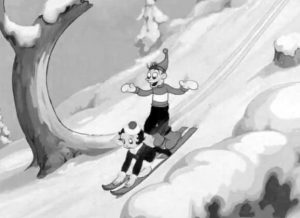 Pudgy in Thrills and Chills (Fleischer/Paramount, Betty Boop, 12/23/38, Dave Fleischer, dir., Roland Crandall, anim.) – Chilly, yes, but this one largely falls short on the thrills. Unlike the spectacle of Popeye’s outing above, only one animator is credited on this film – and it feels like it was turned out with half the effort, placing overly heavy reliance upon Fleischer’s rotoscope. Set at a winter resort, Betty and Pudgy try to enjoy an afternoon of figure skating, while a freckle-faced unattractive dunce repeatedly flirts with her for a kiss, and tries to impress her with his inept skiing. Pudgy pursues a fish he sees beneath the ice on the pond, but floats away on an ice floe. Betty too breaks off a patch of ice and almost floats down river, but is saved by a leap across the water of the flirtatious skier. They both pursue Pudgy along the river bank (with one original twist gag – a tree looming ahead uproots itself to jump clear out of their path and let them pass, then lands back in its hole). Pudgy is caught, everyone rolls into a snowball, and the day is routinely saved, as Pudgy, not Betty, gives the skier his reward kiss. Genuine laughs are quite scarce in this film – and yet Myron Waldman’s nowhere around to blame.
Pudgy in Thrills and Chills (Fleischer/Paramount, Betty Boop, 12/23/38, Dave Fleischer, dir., Roland Crandall, anim.) – Chilly, yes, but this one largely falls short on the thrills. Unlike the spectacle of Popeye’s outing above, only one animator is credited on this film – and it feels like it was turned out with half the effort, placing overly heavy reliance upon Fleischer’s rotoscope. Set at a winter resort, Betty and Pudgy try to enjoy an afternoon of figure skating, while a freckle-faced unattractive dunce repeatedly flirts with her for a kiss, and tries to impress her with his inept skiing. Pudgy pursues a fish he sees beneath the ice on the pond, but floats away on an ice floe. Betty too breaks off a patch of ice and almost floats down river, but is saved by a leap across the water of the flirtatious skier. They both pursue Pudgy along the river bank (with one original twist gag – a tree looming ahead uproots itself to jump clear out of their path and let them pass, then lands back in its hole). Pudgy is caught, everyone rolls into a snowball, and the day is routinely saved, as Pudgy, not Betty, gives the skier his reward kiss. Genuine laughs are quite scarce in this film – and yet Myron Waldman’s nowhere around to blame.
In fact, Myron’s animation is sorely missed, as Pudgy’s face appears rather “dead” and expressionless in many scenes. Animation of Betty is also extremely strange for the series. Betty’s design appeared to be in a constant state of flux during this period, everyone seeming to have his own ideas on how to modernize her and distance her from her original “flapper” image. Here, she seems taller, smaller-headed, and more realistically proportioned than ever before – but its not for the sake of bettering the character. Instead, its an excuse to get her to blend in with live action reference footage of a figure skater rotoscoped to draw Betty’s head upon her shoulders, taking up about a third of the cartoon. The effect is unconvincing, and the skating routine dull. To make the cartoon further odd, all music is provided by a combo appearing to consist of a small rhythm section, accordion, bells, little flute-like instruments then known by the nickname “sweet potatoes” (popularized by a rural quartet known as “The Foursome” from the Broadway cast of Cole Porter’s “Anything Goes”), and possibly a kazoo or two. This being from Fleischer’s Florida period, we don’t even have the familiar vocal tones of Mae Questal to warble Pudgy a sprightly tune. All in all, the film comes off as strange, and has to rank as one of the least circulated or known of all the Betty Boop episodes.
Swiss Ski Yodelers (Terrytoons/Fox, 5/17/40, Eddie Donelly, dir.), produced in black and white, opens with a pair of Tyrolean dancers attempting to do a clog dance while wearing skis, to the tune of a traditional folk band. A pig is, however, the center of our attention – a newbie, carrying an instructional book “How To Ski – and Like It.” His beginner’s enthusiasm begins to wane a bit as he sees an ambulance pass, crammed to capacity with the legs of multiple skiers sticking out its rear doors. The pig manages to catch the last ski-train to the summit. He gulps with worried anticipation as the train passes the “5001 1/2 Feet Elevation” sign, and can only see images of that ambulance again. Reaching the peak, the train abruptly tips its passengers out the rear like a dump truck. The pig just misses being fling down the hill with the rest of the skiers. Taking a brief moment to admire the scenery, he lets out a yodel. The “OOOO”s from his “Le-De-Hoo” reverberate off the mountain and come back to hit him in the rear end. He starts out with a gentle push on his poles, sliding very slowly on a gentle slope, and is quite pleased with himself – until a group of other skiers cross his path at full speed and flip him into the snow. As he attempts to right himself, he observes a side attraction of another tourist placing a rocking chair at the edge of a cliff and rocking precariously, giving the pig the willies. But the other tourist has the situation well under control, and soars down the cliff face, using the chair’s runners as his skis while comfortably seated for the ride. The pig tries again for a slow takeoff, but three skiers approach single-file behind him and push him to full speed. The pig swerves down a crooked mountain trail and comes to rest perched over a chasm, the tips of his skis barely supporting him on the edges of opposite cliffs.
It’s too slippery for him to get a footing on either cliff to extricate himself, so he gets an idea to enlist help. He whistles at a passing mountain goat, and temptingly waves his rear end at the goat for an easy target. To his surprise, the goat ignores his derriere and starts to chew off the tip of one of his skis! The pig moans in fright, and finally the goat gives him a butt and gets him on his way again. In similar fashion to “I-Ski Love-Ski You-Ski”, the pig straddles ravines that open up between his legs. He crashes through a tree trunk, leaving a tunnel shaped in his image, while one owl in its branches above comments to another owl, “Hoo? Hoo?”, with the other merely shrugging his shoulders to indicate he has no idea. Continuing his downhill path, the pig collides with a sign, reading “Ski Jump”. “Whoooooooa!” shouts the pig, and pulls on the forward ends of his skis to try to brake. Down the ramp he flies, into the air, and crash into the snow, his skis leaving the imprint of X marks the spot. In subterranean cutaway view, the pig continues to plunge through the snow, popping into the underground lair of a bear’s cave. The bear awakens and appears to have the pig cornered. The scene dissolves to an army of St. Bernards who receive a distress call in the manner of a police radio broadcast. They emerge from their rescue station in mass numbers, with one stopping to substitute in place of his brandy barrel a keg five times its size marked “Ginger”. The dogs link together to form a canine bridge to cross a canyon, and finally arrive at the scene of the X. One lowers a lasso into the hole, catches something, and hauls the line in – but only retrieves the skier’s empty skis. The dogs bow their heads, assuming the traveler is lost. However, down in the cave, the camera reveals that the bear and the pig have become friends, as the pig claims a pot of chips while beating the bear in a friendly game of poker, the bear grumbling as the camera irises out. A clever, well-animated and action-packed episode, from one of the studio’s best years.
Sport Chumpions (Warner, Merrie Melodies, 8/16/41 – I. (Friz) Freleng, dir.)- A spot-gag potpourri of sports blackouts. The skiing scene depicts the highest ski jump ever constructed at Lake Placid, with a waiting skier knocking his knees in nervous anticipation. He takes off, as the camera follows him dramatically down the ramp, and reaches the end of the jump – which is practically flat to the ground, and launches him a distance of approximately two feet before planting his landing.
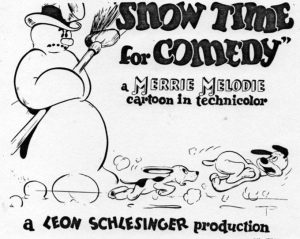 Snow Time For Comedy (Warner, Merrie Melodies, 8/30/41 – Charles M. (Chuck) Jones, dir.), finds Jones’ two curious puppies in the locale of a winter ski resort. As usual, a bone is the cause of their woes, as big dog pursues little dog for the tasty treat. They chase their way up the steps to a ski jump. While little dog pauses in hesitation at the ramp’s drop-off point, big dog barrels right into him, sending both sliding down, the bone in front of them. As they land on an icy pond, each tries to out-position the other to be the first to sink his teeth into their objective. But the little dog misses and slides to the edge of the pond ice, riding a small floe into the center of the open lake. Big dog misses the open water, but crashes through a beaver dam (reducing it to a wooden teepee), then sliding into a snowbank and face first into a tree trunk. Later in the film, the bone winds up on a chair lift, falls out of the seat at the top of the hill, and precariously balances at the peak edge. Little dog jumps off another chair after it – and sends himself and the bone sliding down the slope. They roll into a snowball – which grows into the shape of a giant dog carrying a bone, sliding down the hill. The snow-encased pup comes to the now often rebuilt beaver dam (which the pups have wrecked four times in the course of the picture), and crashes into the dam again – but this time the crash does something positive – expanding the dam with the added snow to the humongous proportions of Hoover Dam!
Snow Time For Comedy (Warner, Merrie Melodies, 8/30/41 – Charles M. (Chuck) Jones, dir.), finds Jones’ two curious puppies in the locale of a winter ski resort. As usual, a bone is the cause of their woes, as big dog pursues little dog for the tasty treat. They chase their way up the steps to a ski jump. While little dog pauses in hesitation at the ramp’s drop-off point, big dog barrels right into him, sending both sliding down, the bone in front of them. As they land on an icy pond, each tries to out-position the other to be the first to sink his teeth into their objective. But the little dog misses and slides to the edge of the pond ice, riding a small floe into the center of the open lake. Big dog misses the open water, but crashes through a beaver dam (reducing it to a wooden teepee), then sliding into a snowbank and face first into a tree trunk. Later in the film, the bone winds up on a chair lift, falls out of the seat at the top of the hill, and precariously balances at the peak edge. Little dog jumps off another chair after it – and sends himself and the bone sliding down the slope. They roll into a snowball – which grows into the shape of a giant dog carrying a bone, sliding down the hill. The snow-encased pup comes to the now often rebuilt beaver dam (which the pups have wrecked four times in the course of the picture), and crashes into the dam again – but this time the crash does something positive – expanding the dam with the added snow to the humongous proportions of Hoover Dam!
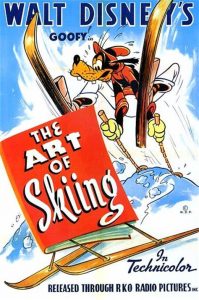 Goofy’s The Art of Skiing (Pronounced SHEEing) (Disney/RKO, Goofy, 11/14/41 – Jack Kinney, dir.) , is of course one of the definitive cartoons on the subject. This was the first “How To” film in which the Goof tackled a recognized sport (although not yet accompanied by the legion of look-alike clones that would populate his team sports in later episodes). Another first was that this was the film for which a professional yodeler was hired to provide a substitute voice in the absence of Pinto Colvig, who was then on a stint at the Fleischer studios in Florida. The yodeler’s recording of “YAAH-HOO-HOO-HOO-HOOEY!!!” became as famous as any stock Disney or Hanna Barbera sound effect, and became a regular feature of the Goof’s personality, continuing long after Colvig returned, and to the present day.
Goofy’s The Art of Skiing (Pronounced SHEEing) (Disney/RKO, Goofy, 11/14/41 – Jack Kinney, dir.) , is of course one of the definitive cartoons on the subject. This was the first “How To” film in which the Goof tackled a recognized sport (although not yet accompanied by the legion of look-alike clones that would populate his team sports in later episodes). Another first was that this was the film for which a professional yodeler was hired to provide a substitute voice in the absence of Pinto Colvig, who was then on a stint at the Fleischer studios in Florida. The yodeler’s recording of “YAAH-HOO-HOO-HOO-HOOEY!!!” became as famous as any stock Disney or Hanna Barbera sound effect, and became a regular feature of the Goof’s personality, continuing long after Colvig returned, and to the present day.
The film opens in a comfortable ski lodge, where Goofy, covered in multiple layers of fur coats and blankets, and resting on a layer of hot water bottles covering the entire bed. snores away, breathing icicles that freeze in mid-air, then fall to the floor with glass-like tinkles. Roused by an alarm clock – and ultimately by the narrator, Goofy exhibits how to dress for the day’s activities – including devising his own challenge of putting on trousers when his feet are already in skis! Finally reaching the peaks by way of a chair lift, Goofy is told in a clever remark by the narrator that “If you should smell something out of the ordinary, don’t be alarmed…It is only fresh air.” Demonstration is performed of how to kick-turn, and to get up when fallen – looking more like pretzel knots than anything the narrator is describing. Goofy’s first summit is approached in the most incorrect way possible – by falling backwards and skiing in reverse down the opposite slope. The “herring-bone” ascent pattern develops perfect symmetry of design as Goofy climbs a slope too steep, then bounces downhill, leaving a trail of full-body silhouettes of himself prone against the snow. Changing direction at high speed separates Goofy from his skis, leaving both to follow separate intersecting paths like a DNA double helix – with both finally colliding and Goofy buried in the snow, his crossed skis landing above to form an “X marks the spot”. (What? Disney stealing a gag from Terrytoons?) Downhill run (way down) and slalom are demonstrated with equal ineptness. Finally, of course, the ski jump – except Goofy forgets to lace his skis, which separate from his feet shortly after takeoff (a gag burned out with much less finesse in Pudgy in Thrils and Chills, above). Making flying leaps for the skiis in midair, Goofy finally manages to get hold of both of them, but not to get them on his feet. Instead, he resorts to something of a return to his “skills” from his first “How To” film, Goofy’s Glider (1940), using the skis as glider wings to maneuver between mountain peaks, then finally crash-land through the window of his own room at the ski lodge. Landing squarely in his bed (albeit rather collapsed from the impact), Goofy falls instantly sound asleep again, to close out the perfect day on the slopes.
Here are some excerpts from this classic cartoon:
Next Week: We continue our downhill run through the 1940’s, including epic ventures by Fox and Crow, Woody Woodpecker, Barney Bear, and Wile E. Coyote.


 Charles Gardner is an animation enthusiast who toils by day as a member of LA Law – but by nights and weekends indulges in classic jazz and ragtime as a performer; and studies classic Hollywood cartoons… maybe a little too much.
Charles Gardner is an animation enthusiast who toils by day as a member of LA Law – but by nights and weekends indulges in classic jazz and ragtime as a performer; and studies classic Hollywood cartoons… maybe a little too much.



































































































































































A brief footnote. There was also a short skiing sequence in “Porky in the North Woods” (12/19/36 – Frank Tashlin, dir.), as the villainous French-Canadian trapper tries to make his escape. But although Tashlin loads the sequence with animals firing projectiles and critters at the trapper to give him “the works”, he really doesn’t generate any gags from the actual skiing at all. Ultimately, the trapper is felled by a trip-rope between trees (the same as in “Alpine Antics”) and winds up buried upside down in the snow, as two beavers use his protruding skis as a see-saw. (This ending looks like it was lifted verbatim from Disney’s “Mickey’s Steamroller”, where Morty and Ferdie play see-saw atop Mickey’s head from debris of the steamroller’s crash.)
I’d rather not say that your posts are ‘going downhill’ …because then I might have to take a ‘powder’. Get it? A POW-dah!
I know of at least two examples of animated skiing prior to 1932. “Yodeling Yokels” (Schlesinger/Warners, Looney Tunes, 23/6/31, Hugh Harman/Rudolf Ising, dir.) finds Bosko and Honey in the Alps, where Bosko falls out of a tree and lands on a pair of skis by accident as Honey tumbles down the mountainside trapped in an ever-growing snowball. Bosko gives chase, deftly skiing between trees and rocks. But when Honey lands in an icy river, Bosko has to rescue her with the help of his dog’s telescoping dentures. While all this action is going on, the cartoon keeps cutting to a scene of a mouse attempting to putt a pea into a hole in a wedge of Swiss cheese, using a piece of dry macaroni as a golf club. It’s every bit as hilarious as it sounds.
Also, in “A Swiss Trick” (Van Beuren, 19/12/31, John Foster/George Stallings, dir.), a chain reaction of butting ibexes causes the foremost one to collide with Tom and Jerry, causing the three of them to tumble downhill. Level-headed Jerry stabilises the ibex by placing his feet on its horns and using them as skis, as Tom, clutching the ibex’s tail in terror, is pulled along behind. When they reach the bottom of the slope, the ibex falls into a chasm, but not to its death — because the X’s where its eyes should be during the skiing scene indicate that the poor old goat is already dead.
In reference to a previous post, there are cuckoo clocks in both of these cartoons.
As they say at Stone Mountain Lodge…. SLALOM!
lol,I got your Flintstone reference.
You’re very sharp, Spike!
Oh, wow…..had not seen “Snowtime” in decades. What a great Treat to revisit. Thank yoo
Not sure if it counts as a cartoon, but https://vimeo.com/121473419 has lots of skiing.
“Thrills and Chills”, like “Cops Is Always Right” seems to have been a headed-out-the-door effort, started in New York and completed in Miami, which might explain why both shorts have an extreme sparse musical score, and why you only have Roland Crandall working on this one (the music seems to have been recorded in New York — the early Miami Fliescher efforts have a ‘hollow’ sound to their musical scores that sound as though the recording studio didn’t have the proper sound dampening and/or proper mic placement. But you don’t hear that in the tracks here).
The Goofy Holler. Walt and his family sometimes spent the Christmas holidays skiing at the Sugar Bowl Ski resort in northern California. Walt was friends with the founder of the resort, Austrian skiing champion and instructor Hannes Schroll. As a favor to Walt, Schroll supplied the yodeling in THE ART OF SKIING and was the first person to do that classic yell that has become so iconic. According to Walt’s daughter, Diane, some of the home movies of Walt’s misadventures skiing inspired a few gags in the Goofy cartoon.
I always feel like that out of all the Terrytoons directors at the time, Eddie Donelly seemed to be one that wanted to break out of Paul’s standard rules and mold. Wonder if he would’ve been good at Warners.
In defence of “Thrills and Chills”:
I like unusual combinations of instruments, and I think the ensemble here really sparkles. (I don’t hear any kazoos, but there’s at least one harmonica as well as a vibraphone.) The ocarina, or “sweet potato” as it was known, had a brief moment of popularity in the late thirties and was heard in other cartoons such as the Color Classic “Ants in the Plants” and Lantz’s “Apple Andy”. Even if the reduced instrumentation was, as J Lee suggests, a matter of necessity — like the chamber ballets composed in the 1920s after the war had decimated European symphony orchestras — I think the music succeeds in conveying an atmosphere of winter fun in the outdoors.
I also like Betty’s appearance in this cartoon. I think the taller design was intended to emphasise her legs, as shapely here as any pair of gams Al Capp ever drew. Likewise I don’t mind the rotoscoping: maybe not as prepossessing as Betty’s hula dance in “Bamboo Isle”, but hardly as freakish as her dancing at the end of “Crazy Town”. Her skating routine might not pass muster at an Olympic qualifying trial, but anyone who could skate like that at the local pond would attract an audience of admirers.
The problem here, and it’s a big one, is that the jerk who harasses Betty all through the cartoon never receives his comeuppance. Getting licked by a puppy doesn’t count; the punishment should fit the crime. One wishes Grampy had been on hand to construct a contraption like the one he devised for the farmer in “Be Human”, with robotic arms that grope and pinch, and repellent giant lips that insistently demand a smooch; and when the jerk tries to escape from its importunities, he turns a treadmill that powers the ski lift. (Good old Grampy, always pioneering alternative energy technologies.) In her later cartoons Betty was often paired with unappealing make leads like Wiffle Piffle, Irving the impractical joker and Henry, the unfunniest living American. It must have been hard for her as a single mother during the Depression after Bimbo ran off and left her to raise their child Pudgy on her own.
When you talk about SNOWTIME FOR COMEDY, the part where the little pup becomes
“The Abominable Snow-Dog” is a belly laugh. First saw it in the mid ’70’s on TV when I was about 8 years old. It STILL floors me to this day
It’s not a “classic” cartoon but I contend that Rocko’s Modern Life’s “Snowballs” is one of the funniest skiing cartoons of all time.
“Every, THING, is five dollars.”
An extremely trivial correction in regards to the colorization comment in the “Alpine Antics” section: “Westward Whoa” was indeed computer colorized.
“Skunked Again” (Terrytoons/Educational Pictures, Kiko the Kangaroo, 25/12/36 — Mannie Davis and George Gordon, dir.; re-issued by Castle Films as “On the Scent”) is a remarkable early skiing cartoon in that the skiers reach their destination via airship — and not just any airship, but apparently the ill-fated Hindenburg! Consider:
1) In 1936, the year this cartoon was released, the Hindenburg was the only purpose-built airship offering commercial transoceanic passenger flights.
2) The airship in the cartoon departs from “Lakehurst Airport”. Lakehurst Naval Air Station was the western terminus of the Hindenburg’s transatlantic route, and the site of its tragic explosion and crash in 1937.
3) As Farmer Al Falfa and Kiko the Kangaroo lead the procession of skiers to the airship, Kiko plays a German march on the tuba, answered by a phrase from “Columbia, the Gem of the Ocean” in the clarinets — representing, in musical terms, the Hindenburg’s regular flight path.
4) The 1924 Aesop’s Fables cartoon “If Noah Lived Today” shows Noah and his animals aboard an actual airship, the Shenandoah. The Shenandoah, the first dirigible built by the U.S. Navy, crashed in Ohio in 1925. It’s incredible that two cartoons from the same producer should have both featured airships that crashed in the following year. But there it is!
On with the cartoon. Farmer Al, Kiko, Puddy the Pup, and their retinue of winter sports enthusiasts are launched skyward in their airship, with a smaller airship labelled “Skunks” separated from it by a length of cable. (This gag also appears in “If Noah Lived Today”.) The skunks, however, want to join the other passengers, so they shimmy over the cable to the main airship, immediately wreaking havoc as they did in “Farmer Al Falfa’s 20th Anniversary”, released four weeks earlier. Farmer Al chases the skunks back with a hatchet, which he uses to cut the cable, causing the skunks to plummet to earth. But fear not — these skunks have parachutes!
Once the airship reaches the North Pole, the passengers disembark and have a jolly time skiing over the icy landscape. Puddy the Pup snowboards down a slope, but stumbles and becomes the nucleus of an even-growing snowball, which knocks over a battalion of penguin soldiers like so many bowling pins. As Farmer Al and Kiko go skate sailing over the ice, they knock over a walrus policeman and four igloos (barracks for the penguin soldiers) before ending up in the icy water. The penguins fish them out, their bodies encased in blocks of ice, and put them on trial for their crimes.
Things are looking bad for our heroes, when who should blow in but the parachuting skunks! Court is hastily adjourned, Al and Kiko break out of their icy bonds, and all the skiers beat a quick retreat to the airship. The skunks climb up the anchor line, vexing Farmer Al, who is struggling on a rope ladder. He falls and lands in the frigid ocean, and the cartoon ends with him swimming frantically away as the skunks dance merrily on his back. Skunked again! Oh, the humanity!